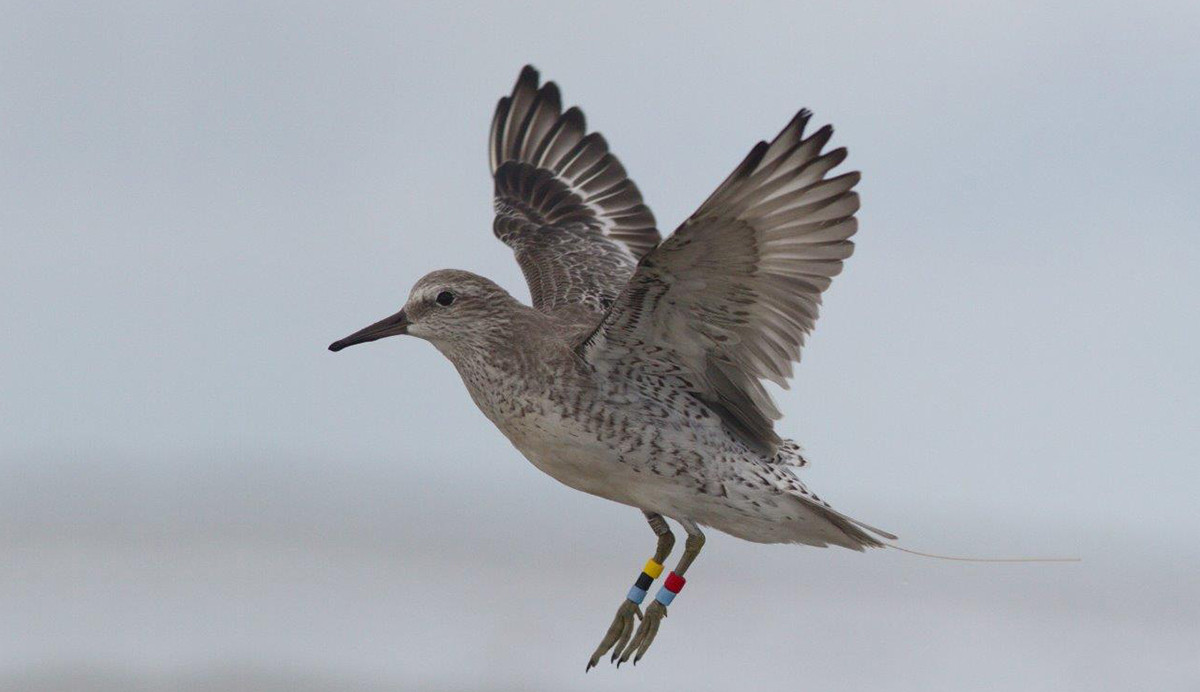Kanoet is kanarie op de toendra
~~~ for english scroll down ~~~
Voor zijn masterstudie dook bioloog Thomas Leerink in een bijzondere wadvogel: de kanoet. ‘Er zijn zes verschillende “versies” van de kanoet, waaronder één die op Groenland en IJsland broedt en bij ons in voor- en najaar bijtankt en ook overwintert, en een andere die in Siberië broedt en via een tussenstop in de Waddenzee in Afrika overwintert.’
Vaderzorg
‘Kanoeten zijn eigenlijk heel geëmancipeerde vogels. Het vrouwtje legt de eieren en broedt ze uit, vervolgens vertrekt zij weer naar het zuiden en zorgt vader voor zijn jongen op de toendra. Maar dat gaat steeds lastiger. De klimaatverandering gaat in het hoge noorden sneller dan bij ons. Daardoor komen de insecten tegenwoordig al uit de bodem voordat de kanoetenkuikens uit het ei kruipen. Er dreigt dan ook voedselgebrek. Uit onderzoek aan de kanoeten die in Afrika overwinteren en in Siberië broeden, blijkt dat die steeds lichter en kleiner zijn als ze weer op tijd naar het zuiden moeten vertrekken. En juist de kleinste kanoeten hebben het in hun winterkwartier in Afrika het zwaarst.’
Uitblinker en kanarie
In zijn gedicht heeft Bas ten Have heel mooi verwoord wat een uitblinker de kanoet eigenlijk is, met zijn onwaarschijnlijke trektocht op de energie van schelpdieren. Tegelijk is de kanoet eigenlijk ook een soort kanarie in de kolenmijn: hij waarschuwt ons dat het klimaat nu wel heel snel aan het veranderen is, en dat wij daar zelf vroeg of laat ook last van zullen krijgen.’
Informatie over het onderzoek waar Thomas aan meewerkte staat in een video op de NIOZ-site, en in de kinderboeken die hij schreef, Uitblinkerz en Gek op Trek.

Knots as the canaries of the tundra
For his master’s thesis, biologist Thomas Leerink studied an unusual species of wading bird known as the knot. ‘There are six different “versions” of the knot, including one that breeds in Greenland and Iceland and refuels and overwinters here in spring and autumn, and another that breeds in Siberia and overwinters in Africa after a stopover in the Wadden Sea.’
Paternal care
‘Knots are actually very emancipated birds. The female lays and hatches the eggs and then migrates south again, while the father stays to look after the young on the tundra. But that’s getting harder and harder. Climate change is happening faster in the extreme north than it is here. As a result, the insects are already emerging from the ground before the knot chicks hatch from the egg. So a lack of food is a real risk. Research on the knots that overwinter in Africa and breed in Siberia shows that they are increasingly lighter and smaller when the time comes to migrate south. And it’s the smallest birds that have the hardest time in their African wintering grounds.’
Remarkable canary
‘In his poem, Bas ten Have expressed very nicely what a remarkable bird the knot actually is, with its unlikely migration powered by shellfish. At the same time, the knot acts as a kind of canary in the coal mine: it warns us that the climate is now changing very quickly, and that sooner or later we humans will be affected too.’
Information about the Dutch books Thomas has written for children Uitblinkerz and Gek op Trek.

SEA Art tour Dichter bij Zee
By differtent poets
Dichter bij Zee is an open-air art project held annually close to the sea. For inspiration, this year the ten participating poets have been paired with NIOZ scientists . A "Dichter bij zee" brochure has been produced (in Dutch) and is available at Strandpaviljoen Paal 9. Read more ...